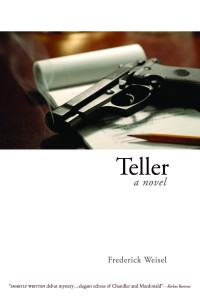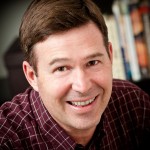 Santa Rosa author Frederick Weisel wrote a great chapter in The Press Democrat’s “Sonoma Squares Murder Mystery” last spring. Here you can read the first chapter of his debut full-length mystery, “Teller: A Novel.”
Santa Rosa author Frederick Weisel wrote a great chapter in The Press Democrat’s “Sonoma Squares Murder Mystery” last spring. Here you can read the first chapter of his debut full-length mystery, “Teller: A Novel.”
The book is set in Sonoma County, Weisel writes, “with scenes in Santa Rosa, Kenwood, Occidental, Bennett Valley, Oakmont Village, and Chalk Hill Road. The novel is told through the eyes of a washed-up ghostwriter of celebrity autobiographies, named Charlie Teller, who tries to solve a friend’s murder. But the mystery has a twist. As Charlie investigates the crime, he also reflects on his own life, remembered through his association with his former clients: an aging novelist, a rock musician, an Olympic athlete, and others. And so the novel includes a second story-line—a series of miniature memoirs that reveal the rise and fall of Charlie’s career.”
Kirkus Reviews calls the novel “a smartly written debut mystery, with elegant echoes of Chandler and Macdonald. . . . A sophisticated literary whodunit that proves lives are harder to solve than crimes.”
Teller: A Novel
by FREDERICK WEISEL
Chapter 1
In March of that year, I saw a man named Paul Barkley shot to death. It happened late at night in the parking lot of a café in Santa Rosa called Galileo’s.
I knew Barkley slightly. He’d done me a favor, and I’d been looking for a way to repay him. Barkley himself said he didn’t want anything in return. He just hoped it would all work out. Later that’s what I remembered—the hopefulness of his gesture.
My name’s Charlie Teller. For most of my life I’ve made a living as a ghostwriter of celebrity autobiographies. Entertainers and sports figures. More than a dozen books in all. The most famous was on the doomed Olympic speed skater Tina Terrill.
At the time of this story I hadn’t worked for several years. I’d come up from Los Angeles after the Christmas holidays, trailing my ex-wife and daughter, Jill and Lucy, to this small town. I found Galileo’s on the second night, and was partway through my meal at the bar when I heard my name spoken behind me. Turning, I found a man with a round, boyish face and dressed in a silk shirt that billowed outside his trousers. He raised both hands, palms out, in a posture of mock surrender and apologized for the intrusion. He said that his name was Paul and that he owned the café and was with a group across the room. I was known to him from a photo in a magazine feature a few years before. He enjoyed my books, especially the one on Virginia Hardy—which is what most people say.
Barkley was polite enough that night not to mention my recent eclipse or to ask why I was in town. We spoke for a few minutes, and then he invited me to join his party. He was one of those people whose persuasion is founded on such perfect confidence in what they’re urging you to do that my agreeing to have an after-dinner drink with his friends was like joining a winning team. We stood together while he introduced the people around the table. He put his hand on my shoulder. “This is my friend Charlie Teller,” he said.
The conversation that night was about Bikram yoga (one of the party had just joined a class). In a lull, Barkley leaned close to me and said he knew someone locally who would make a perfect subject for me. Before I could say a word, he excused himself and made a call.
His subject turned out to be the developer Rajiv Patel, who had emigrated from India as a child and for the past forty years had made a national reputation for building thousands of multistory parking structures. “The Prince of Park,” they called him. He lived in a valley east of Santa Rosa. I had heard of Patel, of course. He was rumored to be among the richest men in America. It wasn’t really my type of project—my expertise is fragility. But I hadn’t received many offers lately, and so I made no protest as Barkley arranged my meeting with the titan of capitalism.
Like so many things with Barkley, the arrangements were accomplished effortlessly. Within a week I had moved into my own apartment on the Patel estate—a sprawling compound called Shanti Bhavan—and accepted the task of what the old man referred to as “compiling my papers.”
And so began my new life: During the day I interviewed Patel or wrote. Several nights a week, I drove into town to see Jill and Lucy, and to share a dinner with Barkley and his friends. If I had doubts about the enterprise, I recognized it as work I knew how to do. Suddenly employed again, as if the preceding years of idleness had never occurred, I felt grateful for the simple pleasures of the job.
On that night in March, two months after our first meeting, all the regulars were already at Galileo’s when I arrived around ten. It was a clear spring night after weeks of rain, and the group had moved onto the garden patio. Old Motown hits played on the house sound system, and the tables had been spread apart to make a dance floor.
Sitting at one table was John Coffey, Barkley’s business associate in another one of his ventures, a fitness center, and Molly Fryor, a lawyer who was training at the center as a distance runner. Next to them were Stephen Robb, who managed Galileo’s, and Carl Drake, a waiter at the café and Stephen’s lover. Nico Eden, a masseuse at the fitness center, was perched on a stool at the patio bar.
I took a stool beside Nico, who had opened a bottle of wine. I poured myself a glass, and watched Barkley pull Molly up to dance. They made a good team. Molly moved fluidly with the rhythm, while Barkley had a jerky, loose-limbed style of his own invention. From time to time he was urged to new eccentricities by the rest of us.
Between two songs Nico turned to me and kissed my cheek. Nico was a girl of the hour. Looking out from under a head of bleached spiky hair, she was continually trying out new weapons against the conformity of the world around her. As she viewed it, her role in life was to shake things up and, wherever possible, challenge conventions—conventions that seemed to have been invented for no other purpose than just to piss her off. But like many young rebels, she had not yet found her own signature, and so her assault varied. Tonight she wore a faded denim jacket over a minidress, red high-tops, and star-shaped earrings. She was married to a mysterious young man named Vincent, whom the rest of us had never met. Despite our differences in age and cultural mission, Nico and I were—in her own expression—tight. Several weeks earlier, when we first met, she told me I was an eternal friend because I had co-written the autobiography of one of the six people she admired most in the world—the British rocker, Nick White.
Barkley danced to us and, shouting above the music, said he had something to talk to me about. He handed me an envelope. “This is the beginning, pal,” he said. “Hang on to it. I’ll talk to you later.” Then he smiled and danced away.
The envelope was unsealed. I looked inside and saw a sheet of paper and a computer memory stick. I slid the envelope into my jacket pocket.
“He looks happy tonight,” I shouted to Nico.
Nico said something that sounded like “page.”
“Pages?” I asked, touching the envelope in my pocket, but the music drowned out my voice. Nico reached into her woven handbag, drew out a plastic container, and began eating fruit salad with her fingers. Between bites she sang along with the music.
Aretha Franklin’s “Respect” came on. Stephen and Carl got up to dance. I drank more wine and let the intoxication run through me. I was happy to be with these people, listening to this music.
During “How Sweet It Is,” Stephen picked up a call on the phone at the opposite end of the bar. When he returned to the dance floor, his face was red with anger. He drew Barkley away from Molly and began to talk to him. Deserted by their partners, Carl and Molly joined together in a stylized version of a swing routine. My attention was on the dancing couple, when I noticed Barkley lean close to speak to Stephen, who shoved him backward into the wall, and walked out the service corridor toward the kitchen. It took a moment for the scene to register with the dancers, and then Carl left to follow Stephen.
Barkley shrugged at us, and resumed his dance with Molly. Percy Sledge began to sing “When a Man Loves a Woman,” and Nico asked me to dance. I declined, but she said, “OK, just hold me while I do,” and pulled me onto the dance floor.
We moved slowly between the tables. She pressed her head close to mine, and I felt her hair on my lips. Her hands were sticky from the fruit. Once when we passed Barkley, he put his arm around me and smiled.
We danced two more songs, and then I quit, dizzy from the drinks and my growing suspicion that Nico was not wearing anything under her dress. I went to the restroom and washed my face, and then feeling the envelope in my pocket, hurried back to the patio to find Barkley.
The music had stopped, and Barkley was gone. “You just missed him,” Molly said. I ran outside, but by the time I reached the café parking lot, I couldn’t see anyone. Knowing that Barkley liked to park his vintage Mercedes away from other cars to avoid scratches, I headed toward the back of the lot.
As I made my way between parked cars, I heard voices. A figure moved in the dark. Then came three loud claps, as if someone were dropping heavy books onto a table. A small pickup with a camper shell drove toward me. The truck roared past and disappeared up the street, through a red light, toward the freeway on-ramp.
The Mercedes sat at the end of the lot where the truck had come from. At a distance, I could see a figure in the front seat. I called Barkley’s name and jogged toward the car. With a few steps, I could make out one side of his boyish face lit by the lot’s orange lights. But there was something wrong, too. The head was tipped onto the seat back, and in the dim light, I saw a shadow spreading down the passenger window. As I reached the driver’s side, I heard a sound pouring out of the open window of the dark car. Violins racing up the scale, and ahead of them, a woman’s voice rising high and cold in the night sky.
 For more on “Teller:” Excerpts, an interview, videos about the writing of the novel, and “out-takes” (deleted scenes) can be found at: www.frederickweisel.com.
For more on “Teller:” Excerpts, an interview, videos about the writing of the novel, and “out-takes” (deleted scenes) can be found at: www.frederickweisel.com.
To see all the “Sonoma Squares Murder Mystery” writers and their chapters, click here.

